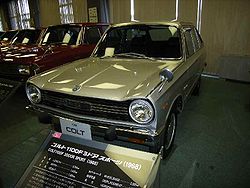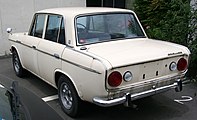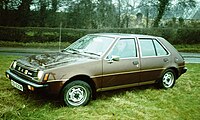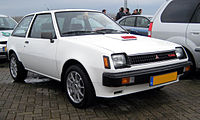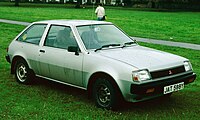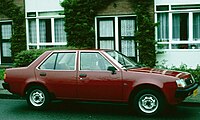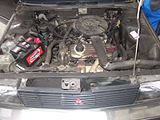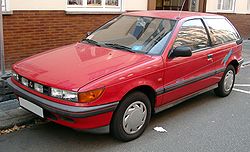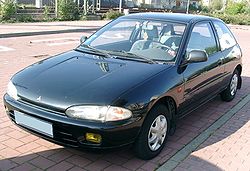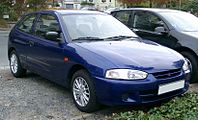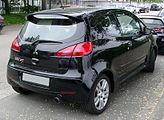Mitsubishi Colt
| Mitsubishi Colt | |
|---|---|
| Production period: | 1962-2012 |
| Class : | Small car , lower middle class , compact class |
| Body versions : | Sedan , hatchback , station wagon , Combi Coupé , Cabriolet |
| Previous model: | Mitsubishi 500 |
| Successor: | Mitsubishi Space Star |
Mitsubishi Colt are a series of passenger cars produced by the Japanese car manufacturer Mitsubishi Motors . From autumn 1962 to autumn 1969, all Mitsubishi cars, with the exception of the small Minica and the large Debonair , were called “Colt”, supplemented by a number for the displacement that ranged from 600 to 1500.
Colt has been a model name since the end of 1978 . The first four model generations are assigned to the compact class; the fifth and sixth generations were smaller and are therefore considered small cars by today's standards . The Colt, which was temporarily built by NedCar in Born from 2004 , was also available as a convertible from 2006 to 2009.
In some countries the Colt is sold under the name Mirage .
Name origin
Colt means “male foal” or “young horse”. The choice of name was possibly intended to signal that the Colt is the smallest vehicle in the Mitsubishi product range. Regardless of this, 'Colt' is a slang term for revolver .
history
In the fall of 1962, the Colt 600 was launched as the successor to the Mitsubishi 500 . With the same technology with two-cylinder rear engine and the same wheelbase, the body was revised and enlarged. A few months later, a lower middle class notchback sedan was also offered. The designer Giovanni Michelotti drew the Colt 1000 with relatively large windows. Soon a three-door delivery van ( Mitsubishi Colt Van ) came on the market. In 1964 Mitsubishi sold almost 30,000 of the delivery van version.
In 1965, Mitsubishi took fourth place among all Japanese manufacturers with 46,000 units sold. In the same year, the successor to the Type 600, the Colt 800 F , and just one month before its market launch, the larger Colt 1500 appeared . Thanks to the successful Colt model family, production reached a new high in 1968 with 130,253 cars.
In the 1970s and early 1980s, the Colt was delivered with a countershaft transmission with two separate shift levers. By combining the four forward gears with two switchable reduction gears on the axle drive, eight forward gears were possible, of which only six were useful.
The Colt was booming in the 1990s . The fourth generation ( CA0 ) appeared in spring 1992 and the fifth ( CJ0 ) in summer 1996 . The notchback version of the Colt was in u. a. sold in Europe as Mitsubishi Lancer .
In mid-2004 Mitsubishi launched the sixth European generation of the Colt. This had the same floor pan as the Smart Forfour , and Daimler-Benz was significantly involved in the development with its technical know-how. It was available as a three-door ( CZ3 ), as a five-door and from 2006 to 2009 also as a four-seater convertible ( Colt CZC ).
Colt 600 (1962-1965)
In autumn 1962 Mitsubishi presented the new Colt 600 as the successor to the first post-war vehicle 500 . The 90 km / h fast car was similar to the Goggomobil and the Fiat 500. The displacement of the first Colt was 594 cm³ and its output was 18 kW / 25 PS. The body was much more angular and more modern than its predecessor.
Colt 800 / 1000F / 1100F (1965-1969)
| 800 / 1000F / 1100F | |
|---|---|
|
Mitsubishi Colt 1100F (1965-1969) |
|
| Production period: | 1965-1969 |
| Body versions : | Station wagon , station wagon coupé |
| Engines: |
Petrol engines : 0.8–1.1 liters (33–54 kW) |
| Length: | 3650 mm |
| Width: | 1450 mm |
| Height: | 1370-1389 mm |
| Wheelbase : | 2200 mm |
| Empty weight : | 695 kg |
In mid-1965 Mitsubishi replaced the 600 with the much larger Colt 800. This was also designed completely different technically. Instead of the two-cylinder four-stroke rear engine in the Colt 600, it had a water-cooled three-cylinder two-stroke front engine with a displacement of 843 cm³ and an output of 33 kW / 45 hp. The car was available as a three-door hatchback coupé, later also as a four-door hatchback sedan.
Mitsubishi introduced the three-cylinder two-stroke engine at a time when DKW and Saab abandoned this design. But the two-stroke engine did not meet with unanimous approval in Japan either. From autumn 1966 there was therefore also the Colt 1000F with the one-liter four-stroke four-cylinder engine of the larger Colt 1000 with 40 kW (55 hp). In 1968 the Colt 1100F appeared with the engine of the Colt 1100. At the same time, the Colt 800 and in May 1969 the Colt 1000F was discontinued. All that remained was the Colt 1100F, which had been produced since 1968 (from 1969 called Colt 11F) with a 1.1-liter four-cylinder engine, which was also available as a Super Sport version with 74 SAE hp (54 kW).
Colt 1000/1100/1200/1500 (1963-1970)
| Colt 1000/1100/1200/1500 | |
|---|---|
|
Mitsubishi Colt 1200 (1968-1970) |
|
| Production period: | 1963-1970 |
| Body versions : | Limousine , station wagon |
| Engines: |
Petrol engines : 1.0–1.5 liters (37–62.5 kW) |
| Length: | 3820 mm |
| Width: | 1490 mm |
| Height: | 1395-1420 mm |
| Wheelbase : | 2350 mm |
| Empty weight : | |
As the first model in the lower middle class, Mitsubishi produced the Colt 1000 from June 1963 with a one-liter four-cylinder four-stroke engine, which was later also used in the 1000F. A four-door notchback sedan and a five-door station wagon were offered.
In 1965 the Colt 1500 with a 70 hp machine was added, in September 1966 the Colt 1100 replaced the 1000, in May 1968 the Colt 1200 with 46 kW (62 hp) followed the 1100; at the same time the Colt 1500 was modernized. In August 1968 the 1500 Super Sport appeared with a two-carburetor system and 62.5 kW (85 PS) and a top speed of 155 km / h.
Production of 1200/1500 ended in mid-1970. As a result, the early Galant models officially bore the name Colt Galant in Japan; in export, the name was not revived until the beginning of 1978 with the A150 series, which was called Mitsubishi Mirage in Japan .
Colt (A150, 1978-1984)
| 1st generation | |
|---|---|
|
Mitsubishi Colt three-door (1978–1982) |
|
| Production period: | 1978-1984 |
| Body versions : | Station wagon |
| Engines: |
Petrol engines : 1.25-1.4 liters (40-77 kW) |
| Length: | 3790 mm |
| Width: | 1590 mm |
| Height: | 1345 mm |
| Wheelbase : | 2300 mm |
| Empty weight : | 810-860 kg |
After the Colt celebrated its European premiere at the Geneva Motor Show in February 1978, it was also introduced in Germany in December of that year and quickly established itself as the best-selling Mitsubishi model there. From May 1979 a five-door variant with a longer wheelbase was available in addition to the three-door model.
The special technical feature of the Colt was its so-called 4 × 2 gearbox, a four-speed gearbox with a countershaft, which offered an economical longer gear ratio in the economy level and a shorter gear ratio in the sport level which was advantageous for acceleration.
In January 1980 the Colt GT followed with sporty equipment, in September 1981 the Colt Turbo with 77 kW (105 PS) 1.4-liter engine.
In July 1982 the Colt underwent a minor facelift with a modified front and a new dashboard. There was also a Lancer F (or Fiore ) until the summer of 1983 . This represented the notchback version of the Colt A150. In contrast to the usual Lancer, the Lancer F had front-wheel drive.
Customers valued the Colt above all for its spaciousness, its economy, its extremely high reliability and its favorable price-performance ratio.
| Mitsubishi Colt | 1200 | 1400 | |
|---|---|---|---|
| engine | 4-cylinder in-line engine (four-stroke), front transverse | ||
| Displacement | 1244 cc | 1411 cc | |
| Bore × stroke | 69.5 × 82 mm | 74 × 82 mm | |
| Power at 1 / min | 40.5 kW (55 hp) at 5500 |
51.5 kW (70 hp) at 5000 |
|
| Max. Torque at 1 / min | 90 Nm at 3500 | 106 Nm at 3500 | |
| compression | 9.0: 1 | ||
| Mixture preparation | 1 downdraft twin carburetor | ||
| Valve control | Overhead valves (overhead camshaft, chain), light alloy cylinder head | ||
| cooling | Water cooling | ||
| transmission | 4-speed gearbox a.W. with countershaft transmission with "Power" and "Economy" position front-wheel drive |
||
| Front suspension | Suspension strut axle, lower wishbones with tension struts, coil springs, stabilizer | ||
| Rear suspension | Independent suspension, longitudinal swing, coil springs | ||
| body | Sheet steel, self-supporting | ||
| Front / rear track | 1370/1340 mm | ||
| wheelbase | Three-door: 2300 mm, five-door: 2380 mm |
||
| Dimensions | Three-door: 3790 × 1585 × 1350 mm. Five-door: 3895 × 1585 × 1350 mm |
||
| Empty weight | 760-805 kg | 770-815 kg | |
| Top speed | approx. 145 km / h | approx. 155 km / h | |
| 0-100 km / h | n / A | ||
| Consumption (liters / 100 km) | approx. 9-11 | approx. 8-12 | |
| price | DM 10,490 (12/78) | DM 11,490 (12/78) | |
Colt (C10, 1984-1988)
| 2nd generation | |
|---|---|
|
Mitsubishi Colt three-door (1984–1988) |
|
| Production period: | 1984-1988 |
| Body versions : | Station wagon |
| Engines: |
Petrol engines : 1.2-1.6 liters (40-92 kW) Diesel engine : 1.8 liters (43 kW) |
| Length: | 3870-39 mm |
| Width: | 1635 mm |
| Height: | 1360 mm |
| Wheelbase : | 2380 mm |
| Empty weight : | 855-945 kg |
In February 1984 Mitsubishi Motors presented the second European generation of the Colt. The hatchback was available in four engine variants, including a diesel engine for the first time. The 1.5-liter gasoline engine was available in a manual and an automatic version.
Engines
Otto engine:
- 1.2 l, 40–44 kW (55–60 hp), 02.1984–03.1988
- 1.5 l, 51–55 kW (70–75 hp), 08.1985–03.1988
- 1.6 l turbo, 92 kW (125 hp), 02.1984–03.1988
- 1.6 l turbo, 77 kW (105 hp), 07.1986–03.1988
Diesel engine:
- 1.8 l, 43 kW (58 hp), 02.1984-09.1986
- 1.8 l, 44 kW (60 hp), 09.1986–03.1988
Colt (C50, 1988-1992)
| 3rd generation | |
|---|---|
|
Mitsubishi Colt (1988-1992) |
|
| Production period: | 1988-1992 |
| Body versions : | Station wagon |
| Engines: |
Petrol engines : 1.3-1.8 liters (44-100 kW) Diesel engine : 1.8 liters (44 kW) |
| Length: | 3950 mm |
| Width: | 1670 mm |
| Height: | 1380-1425 mm |
| Wheelbase : | 2385 mm |
| Empty weight : | 850-1155 kg |
The third generation appeared in April 1988. It was only available as a three-door model, as the previous five-door model was replaced by the Lancer with hatchback.
All models had a five-speed gearbox, the petrol engines a regulated catalytic converter. The powerful versions no longer had a turbo engine, but a high-performance naturally aspirated engine with four valves per cylinder. The top model was the Colt 1800 GTI-16V with 100 kW (136 PS), ABS, firmer suspension and power steering.
In the summer of 1990 the engines were changed from 8 valves to 12 or 16 valves.
Engines
Otto engine:
- 1.3 8V, OHC (4G13), 44 kW (60 PS), torque 96 Nm at 3000 rpm, (04.1988-06.1990)
- 1.3 12V, OHC (4G13), 55 kW (75 PS), torque 102 Nm at 4000 rpm, (07.90–03.1992)
- 1.5 8V, OHC (4G15), 62 kW (84 PS), torque 122 Nm at 3000 rpm, (04.1988-06.1990)
- 1.5 12V, OHC (4G15), 66 kW (90 PS), torque 126 Nm at 3000 rpm, (07.1990–03.1992)
- 1.6 GTi 16V, DOHC (4G61), 91 kW (124 PS), torque 142 Nm at 5000 rpm, (04.1988-02.1990)
- 1.8 GTi 16V, DOHC (4G67), 100 kW (136 PS), torque 162 Nm at 5000 rpm, (03.1990–03.1992)
Diesel engine:
- 1.8 8V OHC (4D65), 44 kW (60 PS), torque 113 Nm at 3000 rpm, (04.1988–03.1992)
Colt (CA0, 1992-1996)
| 4th generation | |
|---|---|
|
Mitsubishi Colt (1992-1996) |
|
| Production period: | 1992-1996 |
| Body versions : | Station wagon |
| Engines: |
Petrol engines : 1.3–1.8 liters (55–129 kW) |
| Length: | 3955 mm |
| Width: | 1680 mm |
| Height: | 1365 mm |
| Wheelbase : | 2440 mm |
| Empty weight : | 908-1040 kg |
The fourth generation of the Colt was presented at the Paris Motor Show in March 1992 . This series was only available with three doors.
Engines
- 1.3 ELi \ GLi 12V (4G13), 55 kW (75 PS); 03.1992-05.1996
- 1.5 ELi \ GLi 12V (4G15), 66 kW (90 PS), 03.1992–12.1993
- 1.6 GLi \ GLXi 16V (4G92 MVV), 66 kW (90 PS), 01.1994–05.1996
- 1.6 GLXi 16V (4G92), 83 kW (113 PS), 04.1992–05.1996
- 1.6 16V (4G92 MIVEC), Mirage Cyborg R, 129 kW (175 PS), 04.1992-05.1996 (Japan)
- 1.8 GTi 16V (4G93), 103 kW (140 PS), 04.1992–05.1996
Licensed buildings
The Satria manufactured by the Malaysian manufacturer Proton is identical to the Colt CA0 and was offered in Germany from 1995 to 2001 as a 300 series.
Colt (CJ0, 1996-2003)
| 5th generation | |
|---|---|
|
Mitsubishi Colt (1996-1998) |
|
| Production period: | 1996-2003 |
| Body versions : | Station wagon |
| Engines: |
Petrol engines : 1.3-1.6 liters (55-76 kW) |
| Length: | 3880 mm |
| Width: | 1680 mm |
| Height: | 1365 mm |
| Wheelbase : | 2420 mm |
| Empty weight : | 1035-1080 kg |
The Colt CJ0 followed in June 1996, the basic shape of which was based on previous generations.
The exterior of the Colt was modified in the summer of 1998. The most striking changes were clear glass taillights, round instead of square fog lights and that headlights and indicators were now one part and not two-part as before.
In September 2000 the engine range was revised to improve emissions standards. The 1.3 liter engine now had 82 instead of 75 hp and the 1.6 liter engine 103 instead of 90 hp. The engines now all had a pre-catalytic converter, a modified intake manifold, ignition coils instead of an ignition distributor and 16 valves.
In Japan there was the Colt under the name "Mirage Cyborg" in a fast version with a 1.6-liter MIVEC engine and 175 hp. This was limited to 180 km / h ex works.
Engines
| model | Cylinders / valves / camshaft | Displacement | Max. power | Max. Torque | Engine identification | Vmax | Acceleration 0-100 km / h | construction time |
|---|---|---|---|---|---|---|---|---|
| 1.3 l | 4/12 / SOHC | 1298 cc | 55 kW / 75 PS | 108 Nm | 4g13 | 170 km / h | 12.5 s | 05.1996-09.2000 |
| 1.3 l | 4/16 / SOHC | 1298 cc | 60 kW / 82 PS | 120 Nm | 4g13 | 170 km / h | 12.5 s | 09.2000-09.2003 |
| 1.6 l | 4/16 / SOHC | 1597 cc | 66 kW / 90 PS | 137 Nm | 4g92 | 185 km / h | 10.5 s | 05.1996-09.2000 |
| 1.6 l | 4/16 / SOHC | 1597 cc | 76 kW / 103 PS | 141 Nm | 4g92 | 185 km / h | 10.5 s | 09.2000-09.2003 |
| 1.6 l (only in Japan) | 4/16 / DOHC MIVEC | 1597 cc | 129 kW / 175 PS | 167 Nm | 4g92 | 210 km / h | 7.8 s | 05.1996-09.2003 |
Colt (Z30, 2004-2012)
| 6th generation | |
|---|---|
|
Mitsubishi Colt five-door (2004-2008) |
|
| Production period: | 2004–2012 |
| Body versions : | Station wagon , convertible |
| Engines: |
Otto engines : 1.1–1.5 liters (55–145 kW) Diesel engines : 1.5 liters (50–70 kW) |
| Length: | 3810-3940 mm |
| Width: | 1680-1695 mm |
| Height: | 1535-1550 mm |
| Wheelbase : | 2500 mm |
| Empty weight : | 1040-1275 kg |
| Stars in the Euro NCAP - Crash Test (2005) |
|
The sixth and final generation of the Mitsubishi Colt was introduced in June 2004.
The vehicle was developed together with the Smart Forfour , which was launched at the same time and with which this Colt shared the platform and technical components. Overall, around 40 percent of all parts were the same in both vehicles. Both vehicles were built in the Netherlands by the NedCar company.
The new Colt, who was at that time the first time, with the more powerful of the two provided common-rail diesel engines (three-cylinder Daimler Chrysler) available, recorded in November of that year, Bild am Sonntag with the Golden Steering Wheel from. This was the second time a Colt model had won this award after 1988.
While production of the Smart ForFour was stopped in July 2006, the last Colt Z30 did not roll off the production line until November 16, 2012. The successor is the new "Space Star", which is very similar to this last Colt and not the old, former Space Star.
Technical specifications
| model | Displacement | power | Max. Torque | 0-100 km / h | Top speed | Specialty | construction time |
|---|---|---|---|---|---|---|---|
| Petrol engines | |||||||
| 1.1 MPI | 1124 cc | 55 kW (75 hp) at 6000 min -1 | 100 Nm at 3500 min -1 | 12.9-13.4 s | 165 km / h | not in the CZC | 10.2004-08.2008 |
| 1.1 MPI | 1124 cc | 55 kW (75 hp) at 6000 min -1 | 100 Nm at 4000 min -1 | 13.7, -14.1 s | 165 km / h | not in the CZC / from 05.2009: Cleartec and changes to the gearbox | 09/2008–11/2012 |
| 1.3 MPI | 1332 cc | 70 kW (95 hp) at 6000 min -1 | 125 Nm at 4000 min -1 | 10.4-12.0 s | 180 km / h | also with allshift automatic ; not in the CZC | 06.2004–11.2012 |
| 1.5 MPI | 1499 cc | 80 kW (109 hp) at 6000 min -1 | 145 Nm at 4000 min -1 | 9.8-10.0 s | 190 km / h | in the five-door also with all-shift automatic | 06.2004-08.2008 |
| 1.5 turbo | 1468 cc | 110 kW (150 hp) at 6000 min -1 | 210 Nm at 3500 min -1 | 8.0 s | 210 km / h | only in the CZT and CZC ; with turbocharger | 03.2005-08.2008 |
| 7.4 s | 210 km / h | Colt Ralliart with turbocharger | 10.2008–01.2011 | ||||
| 1.5 turbo | 1468 cc | 144.9 kW (197 hp) at 5290 min -1 | 303.8 Nm at 3420 min -1 | Colt Ralliart with turbocharger Only available in Switzerland |
10.2008–01.2011 | ||
| Diesel engines | |||||||
| 1.5 DI-D | 1493 cc | 50 kW (68 hp) at 4000 min -1 | 160 Nm at 1600 min -1 | 14.4 s | 160 km / h | not in the CZC | 03.2005–12.2007 |
| 1.5 DI-D | 1493 cc | 70 kW (95 hp) at 4000 min -1 | 210 Nm at 1800 min -1 | 9.9-11 s | 178-180 km / h | not in the CZC | 06.2004-08.2008 |
| 1.5 DI-D DPF (open) | 1493 cc | 70 kW (95 hp) at 4000 min -1 | 210 Nm at 1800 min -1 | 9.9-11 s | 178-180 km / h | not in the CZC , with soot particle filter (open system) | 06.2006-08.2008 |
Mitsubishi Colt Cabrio CZC (2006-2009)
Facelift
At the Mondial de l'Automobile in Paris in October 2008, a revised version of the Mitsubishi Colt was presented, which was launched on November 15, 2008. The changes to the three- and five-door hatchback model mainly concerned the appearance.
The production of the diesel engine was stopped due to lack of demand. According to Mitsubishi, only 35% of the body panels from the previous model have been retained.
The front side of the body was sent to the so-called Jet Fighter -Frontpartie the eighth Lancer adjusted generation and had from then on narrower and more angular shaped headlights. The large, two-part radiator grille was limited at the top by a less steep and higher bonnet. The lower part of the bumper on the revised Colt was made of black plastic with recesses for the fog lights. The bumper strips that had been attached all around were no longer required, and the cladding of the A, B and C-pillars is now black instead of the body color. At the rear of the five-door Colt, the tall taillights were made smaller and closed off at the rear window; In addition, reflectors have been integrated into the redesigned and now black rear apron.
In the interior, the steering wheel has been given a new shape, and the previous three round instruments have been replaced by two and an information display has been added. In addition to the revision of the center console with modified controls for operating the air conditioning and audio system, the quality of the materials used is said to have been increased and noise insulation improved. A modified rear seat also increases the maximum trunk volume from 854 to 1032 liters.
The only three-door top model Colt CZT was discontinued after the facelift and was replaced by a new sports model called Ralliart . This was now also available as a five-door model, in which the turbo-charged 1.5-liter gasoline engine with 110 kW (150 PS) was still used. In addition to an optimized chassis with larger front axle stabilizers for better handling, this model featured a Ralliart emblem on the radiator grille, side skirts and a roof spoiler. In addition, it was equipped with a chrome-plated tailpipe at the rear and titanium-colored light-alloy wheels.
As of early 2011, the Colt Ralliart was no longer available. In February 2012 it was announced that production of the Colt and Mitsubishi Outlander at the Born plant (Netherlands) would be discontinued due to insufficient capacities. Instead, the new models from Eastern Europe and Asia are now being delivered.
Colt ClearTec
The Colt ClearTec was a particularly low-consumption and low-emission variant of the Colt that was available from spring 2009.
Technologies such as low-friction tires, an optimized gear ratio, new engine oil with low viscosity and an automatic start-stop system enable fuel consumption and emissions to be further reduced.
Special models
- 2006: remix
- 2009: Polar
- 2010: In Motion
- 2010: In Motion PLUS
- 2010: Edition
- 2011: Xtra
- 2012: 35 years / 35 years plus
- 2012: Athletic
Individual evidence
- ↑ see also en: Mitsubishi Mirage
- ↑ see also English Wikipedia
- ↑ Results of the Colts (2005) in the Euro-NCAP crash test
- ↑ Auto-Bild online edition of October 7, 2008: " Mitsubishi Colt in Paris 2008: Big Snout "
- ↑ Auto-News online edition of October 2, 2008: " Mitsubishi in Paris: The little Colt becomes a jet fighter "
- ↑ http://www.autosieger.de/article11182.html
- ↑ http://www.autobild.de/artikel/mitsubishi-colt-quot-polar-quot-_1012800.html
- ↑ a b http://www.autobild.de/artikel/mitsubishi-colt-quot-in-motion-quot-_1222074.html
- ↑ http://www.bild.de/auto/partner/auto/wie-dreist-ist-das-denn-14495748.bild.html ( page no longer available , search in web archives ) Info: The link was automatically defective marked. Please check the link according to the instructions and then remove this notice.
- ↑ SPS: Mitsubishi Colt Xtra special model: More for less. In: Focus Online . April 7, 2011, accessed October 14, 2018 .
- ↑ https://www.heise.de/autos/artikel/Mitsubishi-Colt-Sondermodelle-zum-35-Jubilaeum-1474913.html
- ↑ SPS: Mitsubishi Colt special model: athletic appearance. In: Focus Online . May 18, 2012, accessed October 14, 2018 .
swell
- Automobile revue. Catalog number 1979
- Joachim Kuch: Japanese automobiles . Motorbuch Verlag, Stuttgart 1990, ISBN 3-613-01365-7 , pp. 121-127.
- Mitsubishi Colt owner's manual. Danish from 2005

